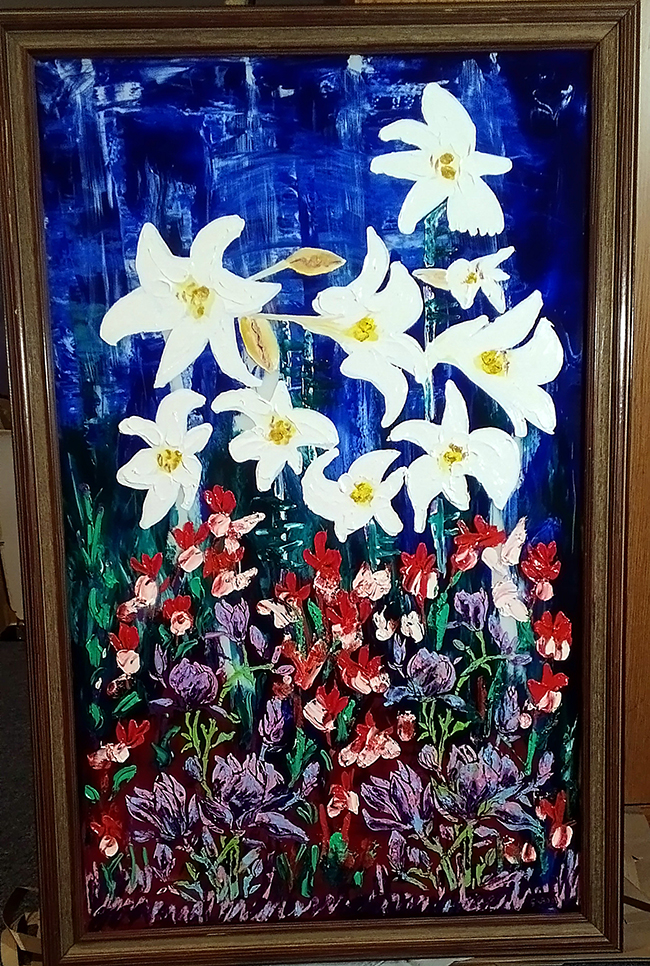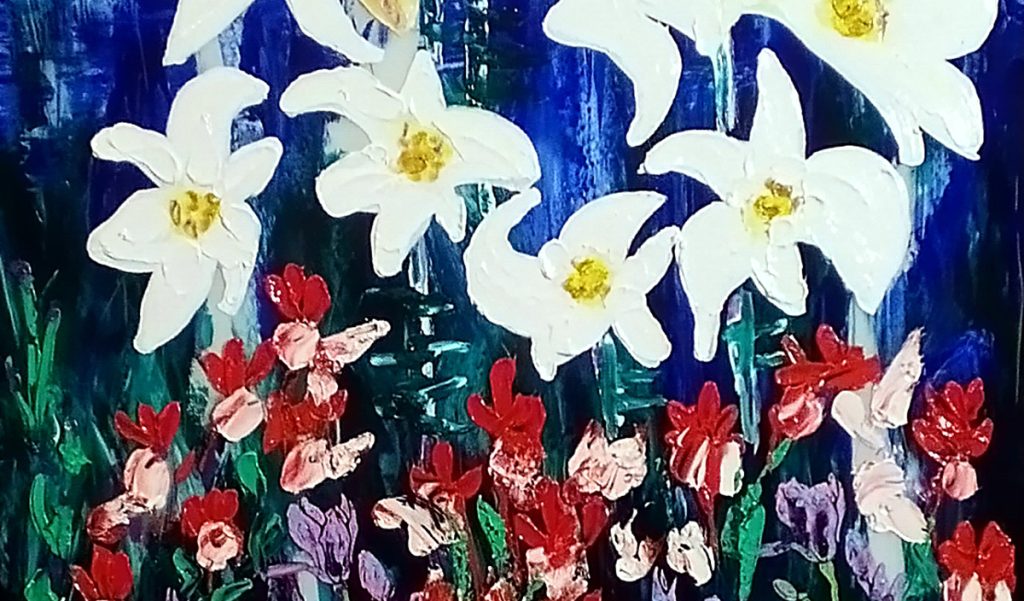Michael Sabin, an artist deeply rooted in upstate New York, has a story as reflective and multifaceted as the glass he has worked with for decades. Born and raised in a small town, his early years in the Finger Lakes—an area often called Mark Twain Country—left a lasting imprint on his imagination. The natural beauty of the rolling hills and lakes was matched by a culture of storytelling and quiet observation, which helped form the foundation of his creative life. Sabin has always sought mediums that can hold light and color in unusual ways, and glass became his lifelong partner. Over the years, he has shaped a career that merges craft and emotion, using the surface of glass not only as a material but also as a metaphor. His art carries echoes of time, memory, and landscape—always bridging the past with the present.

Secret Garden
“Secret Garden” is an oil on glass painting, measuring 24 by 39 ½ inches. At first glance, it draws the eye upward toward the lilies of white rising into a sky that feels timeless. They reach like living flames, tall and tender, the petals catching light in a way that almost vibrates against the glass. Around them blooms a multitude of floral patterns and colors. The scene is less about reproducing nature faithfully than it is about translating its rhythm into something intimate, something that feels carried inside the artist’s memory.
The title, Secret Garden, speaks to what lies beyond the visible. Gardens, in many traditions, are places of both enclosure and openness: walled to keep the world out, yet full of life that spills upward and outward. Sabin uses this tension to guide the viewer. The lilies are contained within the frame, but their vertical lift suggests a refusal to be bound. In this way, the painting whispers of freedom while holding onto the quiet of shelter.
The technique matters here. Oil on glass is not an ordinary choice. Glass does not absorb the paint the way canvas does; it resists, making every stroke deliberate. The palette knife takes over, cutting across the surface, dragging colors, layering textures. Sabin describes it almost as a surrender—allowing the tool and material to guide him, rather than forcing them to behave. This lack of control mirrors the fleeting quality of memory. What comes back to us is never perfect; it is refracted, like light passing through stained glass.
The effect of standing before the work is to feel transported. Sabin himself calls it a kind of time travel, and the painting lives up to that claim. It evokes another century, a gentler time, when days seemed longer and summers endless. The lilies stand as sentinels of serenity, and the surrounding florals weave a tapestry of calm. Looking at it, the mind relaxes, thoughts wander, and you’re taken not just into another place, but into another self—your younger self, perhaps, when wonder was easy to find.
The colors play a large role in this transportation. They are not muted, but neither are they chaotic. They swell across the glass in measured rhythm, each hue amplifying the next. Reds hum against greens, yellows breathe into blues, and the whites of the lilies are like sudden pauses in a symphony. There is harmony without stillness; everything is alive, yet nothing is rushed. This careful balance is what makes the painting linger in the mind.
“Secret Garden” is not just a window into a landscape; it is a mirror into the inner life of the artist. Sabin grew up surrounded by the pastoral calm of the Finger Lakes, and it shows in the serenity of his imagery. Yet the piece is not nostalgia alone. There is also a sense of rebirth, of carrying childhood into adulthood, of letting art bridge the distance between then and now. The lilies, though fragile, are upright and bright, embodying resilience as much as beauty.
What the painting ultimately offers is a meditation on time itself. Life, like a summer garden, is brief in bloom but boundless in memory. Sabin captures this duality through glass, a medium that embodies both fragility and endurance. The flowers may fade, but the image endures, inviting each new viewer into the same suspended moment.
In the end, Secret Garden is less about a place than about a feeling—the serenity of a summer’s day, the wonder of childhood, the timeless pull of color and light. Sabin’s art does not demand explanation. It simply asks you to look, to pause, and perhaps to remember the gardens of your own past.

